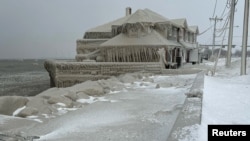Millions of people in the United States took refuge this Monday from the freezing cold caused by a winter storm that has killed at least 34 people in various parts of the country and is expected to claim more lives after having left some residents locked up in snow encircled their homes and cut power to tens of thousands of homes and businesses.
The magnitude of the storm is almost unprecedented, stretching from the Great Lakes near Canada to the border with Mexico.
About 60% of the nation’s population is under some type of weather advisory and temperatures hover well below normal from the Rocky Mountains to the Appalachians, the National Weather Service reported.
Some 1,700 domestic and international flights had been canceled as of 2 p.m. Eastern time Sunday, according to the FlightAware website.
The experts explained that an explosive cyclogenesis had occurred, in which the atmospheric pressure drops very quickly during a storm, near the Great Lakes, where it caused blizzards with snow and gales.
The storm unleashed its full fury on the city of Buffalo, where hurricane-force winds and heavy snow crippled emergency services.
New York Gov. Kathy Hochul said nearly all of the city’s fire trucks were snowbound Saturday, and authorities said the airport would remain closed until Tuesday morning.
The National Weather Service said snowpack at the Buffalo-Niagara Airport reached 109 centimeters as of 7 am Sunday.
Daylight revealed cars covered by almost 2 meters of snow and thousands of houses in the dark due to lack of electricity. As snow piled up on impassable roads, forecasters warned of the possibility of 12 to 24 inches more snow falling in some areas through Monday morning amid 40-mile-per-hour gusts of wind.
Two people died at their homes in Cheektowaga, New York state, because medical personnel failed to arrive in time to treat their health problems, and another person died in Buffalo. Four more deaths were confirmed overnight, bringing the total in Erie County to seven. County Administrator Mark Poloncarz warned that the death toll could rise.
“Some people were found in their vehicles, some in snowbanks on the street,” Poloncarz said. “We know that there are people who have been stranded in their vehicles for more than two days.”
Heavy snowfall, cold weather and power outages the day before prompted some Buffalo residents to leave their homes Saturday for anywhere with heat.
But with city streets covered in a thick layer of white, that wasn’t an option for the likes of Jeremy Manahan, charging his cellphone battery in his parked car after nearly 29 hours without power.
“There is a shelter to keep warm, but it is too far for me to get there. Obviously I can’t drive, because I’m stuck,” Manahan said. “And you can’t be out for more than 10 minutes without getting frostbite symptoms.”
The storm left towns without power from Maine to Seattle. But gradually electricity and heating were restored in different parts.
Concerns about blackouts in eastern states eased on Sunday after PJM Interconnection, the operator of the Atlantic grid, said its companies were able to meet peak electricity demand for the day. Earlier it had asked its 65 million customers to conserve power amid freezing Saturday.
In recent days, deaths associated with the storm have been reported across the country: 12 in Erie County and another in Niagara County, New York; 10 in Ohio, including a power company employee who was electrocuted and victims of various traffic accidents; six drivers in various traffic accidents in Missouri, Kansas and Kentucky; a woman in Vermont who was hit by a tree branch; an apparently homeless man found in freezing Colorado temperatures; and a woman who fell through the ice on a river in Wisconsin.
Connect with the Voice of America! Subscribe to our channel Youtube and activate notifications, or follow us on social networks: Facebook, Twitter and instagram.


![[Img #74664]](https://thelatestnews.world/wp-content/uploads/2024/12/James-Watson-The-controversial-genius-behind-the-double-helix-150x150.jpg)











